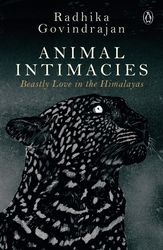Social media spent a week raving, mocking and debating the Indian Army’s “discovery” of yeti footprints in the Himalayas. To understand more about the mythical beast or the ‘abominable snowman’, one could parse Radhika Govindrajan’s Animal Intimacies: Beastly Love in the Himalayas. The most intriguing chapter in the book, which decodes hushed stories and strident narratives on human-animal relationships in the villages of central Himalayas, is The Bear Who Loved a Woman.
The author points out how the Kumaonis have fables aplenty on bears, especially the huge, glossy Asiatic black bear, which consumes a wholesome diet of plants, nuts, honey, fruits and millets or mandua. Women in the region relate to this savage brute as a conceptual “husband”, an object of desire and sexual fulfillment. Their stories follow a similar framework, where an unsuspecting woman is abducted by a bear and is held captive in a cave. The storytellers seldom frame the encounter as sexual violence or rape. The bear is seen as gentler and more loving, so much so that the rescued woman longs to go back to the bear rather than live a mundane life in her marital home. “Even though this meant forsaking human society, she made it clear to villagers that life with and as a bear was preferable to life under the shadow of patriarchal violence,” said a woman to the author.
Interestingly, there is a body of research, as recent as 2017, led by evolutionary biologist Charlotte Lindqvist, which analyses the mitochondrial DNA of yeti remains from museums and private collections. One DNA sample is that of the Asian black bear and the other of the Himalayan brown bear. When well-known climber and author Frank Smythe undertook an expedition to the Bhyundar Valley of Garhwal in 1937 with sherpas, large footprints in the snow sparked fear of “ban manshi” or “mirka”, common names for yeti that pounced on yaks and men. Smythe’s photographs of the footprints were said to be that of the Himalayan brown bear by scientists at the Zoological Society in London back then. Even Daniel C. Taylor, an American scholar who has tracked the yeti for sixty years, concluded in his 2017 book, Yeti: The Ecology of a Mystery, that the ape-like legend of the Himalayas is most likely a bear.
So what is it about these bears that might qualify them as yeti? “I think the interest in the yeti is part and parcel of a broader fascination with a range of non-human creatures (such as bears in Kumaon), who are thought to possess human traits while simultaneously exceeding human ways of being,” says Govindrajan over email. “I am not interested in judging the truth value of such stories, but instead in what they reveal about those who revel in their telling and sharing.” Hence, Animal Intimacies does exactly that. It revels in what the locals believe and share as a process of meaning-making in their daily encounters with animals. But it does so with an intellectual rigour that combines an unwavering mix of humaneness and academic probity.
As Taylor said in a recent interview, “We are more desperate for meaning as we see a greater [environmental] crisis coming upon us. We are grabbing for answers in a mythical animal instead of understanding that the answer is within ourselves.” Animal Intimacies, too, tends to rewire our perception of man-animal cohabitation in the Himalayas with this line of thought.
ANIMAL INTIMACIES: BEASTLY LOVE IN THE HIMALAYAS
Author: Radhika Govindrajan
Publisher: Penguin Random House
Pages: 240
Price: Rs 599



